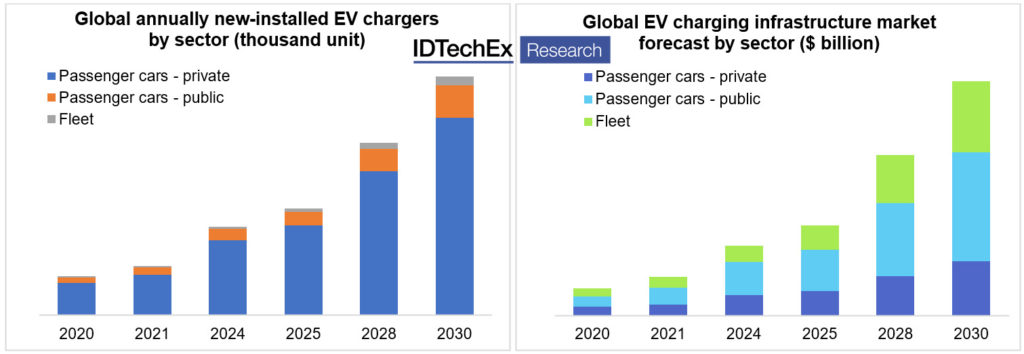With the growing population of plug-in electric vehicles (EVs), the charging infrastructure industry is also progressing quickly to meet the ever-increasing demand for recharging the EV batteries.
The 50kW direct current fast chargers (DCFCs) deployed several years ago are now becoming “slow” as network operators such as IONITY are rapidly ramping up their 350kW DCFC charging stations. Public charging infrastructure, especially fast charging, is very capital intensive and the payback time is long.
This has brought concerns for customers that their investment in certain charging solutions might become obsolete sooner than expected. While the number and diversity of locations of EV charging stations are growing, the installation of charging infrastructure still faces many challenges, especially in urban centres.
The most suitable locations to meet drivers’ charging needs can sometimes be too expensive or too far from available power. For charging network operators, it is not easy to decide the best locations to install charging infrastructure and there are risks that the charging stations become underutilised, which is a common issue found in China and Europe.
Also, it takes months or more to install charging stations, especially for DCFCs, due to permitting requirements and any capacity upgrades that must be negotiated with the local utility.
Mobile charging provides an alternative solution to the traditional fixed charging infrastructure: instead of letting the EV drivers look for charging stations, the mobile charger comes to the vehicle to charge it. Mobile charging can help charging operators quickly build up the infrastructure or test for the best locations with the flexibility to relocate easily with no additional cost.
A mobile EV charger normally consists of energy storage devices (usually batteries) in the form of portable chargers, trolleys, vans and even robots. Through the use of mobile energy storage for charging, the cost and complexity of the charging infrastructure can be significantly reduced, especially for restricted parking areas. It also provides a flexible charging solution for big events where there is no fixed charging infrastructure for temporary charging.

Mobile charging provides a promising charging solution especially for corporate and fleet customers to avoid high upfront cost of installing fixed charging infrastructure, according to a recent research on “Charging Infrastructure for Electric Vehicles 2020-2030“ by IDTechEx.
Although it is expected to remain niche in terms of applications, it is an important complement to stationary charging infrastructure. Mobile charging, especially in the form of robots can also be a promising candidate for charging autonomous vehicles in the future, as demonstrated by Volkswagen’s visionary mobile charging robot prototype.
Volkswagen’s mobile charging concept is not new, but it is the first time an automotive OEM presenting this as part of its holistic charging system. For more detailed analysis on the mobile EV charging market landscape, key market players and their latest developments, please see IDTechEx’s latest report on “Charging Infrastructure for Electric Vehicles 2020-2030“.
According to IDTechEx’s research on electric vehicles, by 2030 there will be over 100 million plug-in EVs on road globally, including passenger cars, buses, trucks and vans which are the most relevant sectors to consider for EV charging infrastructure. Among them, electric passenger cars represent the largest plug-in EV sector in volume while electric fleets such as buses, trucks and vans are expected to grow rapidly in the coming decade, which will drive up demand for charging infrastructure significantly.
The market of EV charging infrastructure will grow at 24% CAGR in the coming decade and reach $40 billion per year by 2030, according to IDTechEx’s research on “Charging Infrastructure for Electric Vehicles 2020-2030“.
Private charging will remain the dominant charging solution in the coming decade despite region disparities and the public charging sector is expected to grow rapidly to meet charging demand, especially in countries like China where many EV drivers don’t have access to private charging. On the other hand, electric vehicle fleets such as buses and trucks require very different charging infrastructure from the existing one built for passenger cars.
The rising population of electric vehicle fleets represents huge opportunities for developing dedicated charging infrastructure for electric buses and trucks. It is worth noting that although electric fleet charging represents less than 5% of the total charging infrastructure in volume, it constitutes over 30% of the total market value of the charging industry, reflecting much more expensive charging infrastructure needed for fleet charging.
Mobile charging is an excellent business model to address some of the current pain-points of the charging infrastructure market. However, it will remain niche in the coming decade, limited to certain applications for the passenger car market.
IDTechEx’s latest report “Charging Infrastructure for Electric Vehicles 2020-2030“ provides a detailed analysis of major charging infrastructure types including conductive charging, wireless charging and alternative solutions such as battery swapping. Under the various charging infrastructure, a detailed analysis of key EV charging technologies such as fast charging, inductive and capacitive charging, robotic and autonomous charging, off-grid charging, mobile charging and vehicle-to-home/grid (V2H/V2G) are presented. The report also offers a comprehensive analysis of the EV charging value chain, the key market players and a business model analysis. A ten-year market forecast on the EV charging infrastructure by region, application, sector and power level will be provided. For a more detailed analysis of the EV charging infrastructure market, please see IDTechEx’s latest report on “Charging Infrastructure for Electric Vehicles 2020-2030“.




